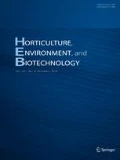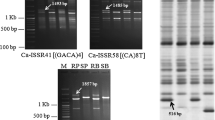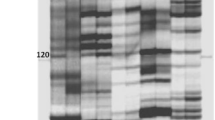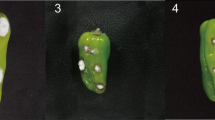Abstract
Anthracnose (Colletotrichum spp.) causes significant yield losses in chili pepper (Capsicum annuum L.), and several loci conferring resistance to this disease have been identified. Seven and one amplified fragment length polymorphic (AFLP) markers were additionally located on LG 12 (CaR12.2, major locus resistant to Colletotrichum acutatum) and LG 9 (CcR9, major locus resistant to C. capsici), respectively, through AFLP analysis combined with extreme bulked segregant analysis (BSA). Among these, two AFLP markers, EtagMcgt04 (CaR12.2) and EtacMccg13 (CcR9), were converted into sequence tagged site (STS) markers (CaR12.2M1-CAPS and CcR9M1-SCAR, respectively), via sequencing analysis of internal and flanking regions of each AFLP marker. The selection efficiencies were 72% for CaR12.2M1-CAPS and 82.5% for CcR9M1-SCAR. These simple PCR-based markers will be useful for breeding cultivars with enhanced resistance to anthracnose, for pyramiding resistances to both C. acutatum and C. capsici, and for further characterization of the locus, including isolation of genes responsible for resistance.
Similar content being viewed by others
Literature Cited
Bradeen, J.M. and P.W. Simon. 1998. Conversion of an AFLP fragment linked to the carrot Y2 locus to a simple codominant PCR-based marker form. Theor. Appl. Genet. 97:960–967.
Collard, B.C.Y., M.Z.Z. Jahufer, J.B. Brouwer, and E.C.K. Pang. 2005. An introduction to markers, quantitative trait loci (QTL) mapping and marker-assisted selection for crop improvement: The basic concepts. Euphytica 142:169–196.
Giovannoni, J., R. Wing, M. Ganal, and S. Tanksley. 1991. Isolation of molecular markers from specific chromosomal intervals using DNA pools from existing mapping populations. Nucleic Acid Res. 19:6553–6558.
Kang, B.K., J.Y. Min, Y.S. Kim, S.W. Park, N.V. Bach, and H.T. Kim. 2005. Semi-selective medium for monitoring Colletotrichum acutatum causing pepper anthracnose in the field. Res. Plant Dis. 11:21–27.
Kim, S.H., J.B. Yoon, J.W. Do, and H.G. Park. 2007. Resistance to anthracnose caused by Colletotrichum acutatum in chili pepper (Capsicum annuum L.). J. Crop Sci. Biotech. 10:277–280.
Kim, S.H., J.B. Yoon, J.W. Do, and H.G. Park. 2008. A major recessive gene associated with anthracnose resistance to Colletotrichum capsici in chili pepper (Capsicum annuum L.). Breeding Sci. 58:131–141.
Konieczny, A. and F.M. Ausubel. 1993. A procedure for mapping Arabidopsis mutations using co-dominant ecotype-specific PCR-based markers. Plant J. 4:403–410.
Kosambi, D.D. 1944. The estimation of map distance from recombination value. Ann. Eug. 12:172–175.
Lee, J., J.H. Hong, J.W. Do, and J.B. Yoon. 2010. Identification of QTLs for resistance to anthracnose to two Colletotrichum species in pepper. J. Crop Sci. Biotech. 13:227–233.
Lin, Q., U.C. Kanchana, T. Jaunet, and O. Mongkolporn. 2002. Genetic analysis of resistance to pepper anthracnose caused by Colletotrichum capsici. Thai J. Agric. Sci. 35:259–264.
Lincoln, S.E., M.J. Daly, and E.S. Lander. 1993. Constructing genetic linkage maps with MAPMAKER/EXP. Version 3.0.: Whitehead Institute for Biomedical Research Technical Report. 3rd ed. Whitehead Institute for Biomedical Research, Cambrige, MA.
Meksem, K., E. Ruben, D. Hyten, K. Triwitayakorn, and D.A. Lightfoot. 2001. Conversion of AFLP bands into high-throughput DNA markers. Mol. Genet. Genomics 265:207–214.
Pakdeevaraporn, P., S. Wasee, P.W.J. Taylor, and O. Mongkolporn. 2005. Inheritance of resistance to anthracnose caused by Colletotrichum capsici in Capsicum. Plant Breed. 124:206–208.
Paran, I. and R.W. Michelmore. 1993. Development of reliable PCR-based markers linked to downy mildew resistance genes in lettuce. Theor. Appl. Genet. 85:985–993.
Park, H.K., B.S. Kim, and W.S. Lee. 1990. Inheritance of resistance to anthracnose (Colletotrichum spp.) in pepper (Capsicum annuum L.) II. Genetic analysis of resistance to Colletotrichum dematium. Hort. Environ. Biotechnol. 31:207–212.
Park, K.S. and C.H. Kim. 1992. Identification, distribution and etiological characteristics of anthracnose fungi of red pepper in Korea. Kor. J. Plant Pathol. 8:61–69.
Prince, J.P., Y. Zhang, E.R. Radwanski, and M.M. Kyle. 1997. A versatile and high-yielding protocol for the preparation of genomic DNA from Capsicum spp. (pepper). Hortscience 32:937–939.
Sambrook, J. and D.W. Russell. 2001. Molecular Cloning: A Laboratory Manual. 3rd ed. Cold Spring Harbor Laboratory Press, Cold Spring Harbor, New York.
Siebert, P.D., A. Chenchik, D.E. Kellogg, K.A. Lukyanov, and S.A. Lukyanov. 1995. An improved method for walking in uncloned genomic DNA. Nucleic Acids Res. 23:1087–1088.
Than, P.P., R. Jeewon, K.D. Hyde, S. Pongsupasamit, O. Mongkolporn, and P.W.J. Taylor. 2008. Characterization and pathogenicity of Colletotrichum species associated with anthracnose on chilli (Capsicum spp.) in Thailand. Plant Pathol. 57:562–572.
Voorrips, R.E. 2002. MAPCHART: Software for the graphical presentation of linkage maps and QTLs. J. Hered. 93:77–78.
Voorrips, R.E., R. Finkers, L. Sanjaya, and R. Groenwold. 2004. QTL mapping of anthracnose (Colletotrichum spp.) resistance in a cross between Capsicum annuum and C. chinense. Theor. Appl. Genet. 109:1275–1282.
Vos, P., R. Hogers, M. Bleeker, M. Reijans, T. van de Lee, M. Hornes, A. Fritjers, J. Pot, J. Paleman, M. Kuiper, and M. Zabeau. 1995. AFLP: A new technique for DNA fingerprinting. Nucleic Acids Res. 23:4407–4414.
Yi, G., J.M. Lee, S. Lee, D. Choi, and B.D. Kim. 2006. Exploitation of pepper EST-SSRs and an SSR-based linkage map. Theor. Appl. Genet. 114:113–130.
Yoon, J.B. and H.G. Park. 2001. Screening method for resistance to pepper fruit anthracnose: Pathogen sporulation, inoculation methods related to inoculum concentrations and post-inoculation environments. Hort. Environ. Biotechnol. 42:389–393.
Yoon, J.B. and H.G. Park. 2005. Trispecies bridge crosses, (Capsicum annuum × C. chinense) × C. baccatum, as an alternative for introgression of anthracnose resistance from C. baccatum into C. annuum. Hort. Environ. Biotechnol. 46:5–9
Yoon, J.B., D.C. Yang, J.W. Do, and H.G. Park. 2006. Overcoming two post-fertilization genetic barriers in interspecific hybridization between Capsicum annuum and C. baccatum for introgression of anthracnose resistance. Breed. Sci. 56:31–38.
Author information
Authors and Affiliations
Corresponding author
Rights and permissions
About this article
Cite this article
Lee, J., Do, J.W. & Yoon, J.B. Development of STS markers linked to the major QTLs for resistance to the pepper anthracnose caused by Colletotrichum acutatum and C. capsici . Hortic. Environ. Biotechnol. 52, 596–601 (2011). https://doi.org/10.1007/s13580-011-0178-5
Received:
Accepted:
Published:
Issue Date:
DOI: https://doi.org/10.1007/s13580-011-0178-5




